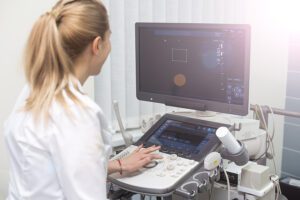Lists of Medical Supplies a New Healthcare Practice Needs
Starting a new healthcare practice requires a variety of medical supplies, depending on the nature of the practice. Our experts at 24×7 Doctors Answering Service created a general list of essential supplies and where to get them.
Diagnostic Equipment:
- Stethoscope
- Otoscope and ophthalmoscope
- Blood pressure monitors (sphygmomanometers)
- Thermometers (digital, tympanic, etc.)
- Electrocardiogram (ECG) machine
- Pulse oximeter
- Spirometer
- Tuning forks
- Reflex hammer
Surgical and Treatment Equipment:
- Minor surgery kits
- Scalpels and blades
- Needle holders
- Sutures and suturing kits
- Sterile gloves
- Sterile gowns and drapes
- Syringes and needles
- Dressings and bandages
- Alcohol swabs and antiseptics
Laboratory Supplies:
- Blood collection tubes and needles
- Urine collection cups
- Microscopes
- Centrifuge
- Blood glucose meters and test strips
- Hemoglobin meters
- Rapid diagnostic tests (like strep test, flu test, etc.)
- Culture plates and media
Medical Furniture:
- Examination table
- Patient chairs
- Physician stool
- Medical cabinets and storage
- Instrument trays and trolleys
- Waiting room furniture
- IV stands
Emergency Supplies:
- Automated External Defibrillator (AED)
- Emergency oxygen tanks and masks
- First aid kits
- Emergency medications (epinephrine, nitroglycerin, etc.)
Personal Protective Equipment (PPE):
- Gloves (sterile and non-sterile)
- Face masks and respirators (N95, surgical masks, etc.)
- Face shields
- Goggles
- Protective gowns
- Shoe covers
Miscellaneous:
- Medical waste containers and bags
- Sharps containers
- Disinfectants and cleaners
- Hand sanitizers
- Biohazard bags
- Patient information pamphlets and leaflets
- Prescription pads
Regarding where to purchase these items, it’s important to note that the best suppliers often depend on your location, specific needs, and budget. In the U.S., some of the most renowned medical suppliers include:
Remember to always ensure that any supplier you choose is reputable and provides high-quality products.

Inventory Management: Best Practices for Managing and Stocking Medical Supplies
In the fast-paced world of healthcare, the efficiency of a medical facility can significantly influence patient outcomes. One of the essential aspects of this efficiency is the management and stocking of medical supplies. Proper inventory management ensures that the right supplies are available when needed, thereby preventing disruptions in patient care. Let’s delve into the best practices for managing and stocking medical supplies in doctor’s offices and healthcare facilities.
1. Regularly Audit Inventory
It’s crucial to have a system in place for regular audits. Whether weekly, bi-weekly, or monthly, consistent checks help identify stock levels, prevent theft, and ensure that items are used before their expiration date.
2. Use a Digital Inventory System
Gone are the days of manual logbooks. Modern healthcare facilities are increasingly turning to digital solutions, like Inventory Management Software (IMS), which provides real-time tracking, automated reorder reminders, and analytics to help optimize stock levels.

3. First-In, First-Out (FIFO) Principle
Adhere to the FIFO principle, especially for perishable items. Always use the oldest stock first to ensure that no supplies expire or become obsolete while sitting on the shelf.
4. Maintain Safety Stock
Safety stock acts as a buffer against sudden increases in demand or disruptions in supply chains. By having a safety stock, you can ensure that your facility doesn’t run out of essential items during emergencies.
5. Build Strong Supplier Relationships
Cultivate relationships with trusted medical supply distributors. Reliable suppliers can provide timely deliveries, inform about new product releases, offer bulk purchase discounts, and might be flexible with payment terms.
6. Optimize Storage Solutions
Organize storage areas efficiently to minimize waste of time during retrieval. Frequently used items should be easily accessible. Ensure that items are stored under appropriate conditions, especially those that require refrigeration or protection from light.
7. Train Your Staff
Ensure that all team members understand the importance of inventory management. Regular training sessions can ensure that everyone is on the same page regarding stocking procedures, usage tracking, and reordering protocols.
8. Set Par Levels
Determine a minimum quantity for each item in your inventory. When stock falls below this level, it’s a signal to reorder. This practice ensures you never run critically low or overstock.
9. Rotate Stock Regularly
Keep an eye on expiration dates. If certain items aren’t moving as quickly as anticipated, consider special promotions, sales, or even donating them before they reach their expiration.
10. Regularly Review and Update Inventory Practices
The world of medical supplies is continuously evolving. Regularly review and adjust your inventory practices to accommodate new products, technologies, and changes in patient care needs.
11. Seek Feedback
Staff members, especially those directly involved with patient care, can offer invaluable insights into the actual needs and usage patterns of supplies. Regular feedback sessions can help streamline the inventory process.
Inventory management in the medical field isn’t just about numbers and stock levels—it directly impacts patient care quality. By adopting and maintaining best practices, healthcare facilities can ensure they are always prepared, efficient, and effective in their patient care endeavors.
Diagnostic Devices: The Latest and Most Reliable Diagnostic Devices for Modern Clinics (and Where to Get Them)
In today’s ever-evolving medical landscape, clinicians heavily rely on diagnostic devices not only for accurate disease diagnosis but also for predicting disease progression and guiding treatment choices.

The wave of technological innovation has ushered in a plethora of new, reliable diagnostic tools. This article aims to highlight some of the latest and most dependable devices for modern clinics, as well as suggestions on where to procure them.
1. Point-of-Care Ultrasound (POCUS) Devices
Overview: POCUS devices are compact, portable ultrasound machines that provide immediate visual information. Their increasing popularity stems from their ability to quickly diagnose conditions, from fluid in the lungs to heart anomalies.
Where to Get Them: Major medical suppliers such as Philips, GE Healthcare, and Siemens offer a range of POCUS devices.
2. Wearable ECG Monitors
Overview: Modern wearable ECG monitors allow for continuous heart rhythm monitoring. They can detect arrhythmias or other abnormalities that might be missed during a short ECG in a medical setting.
Where to Get Them: Brands like AliveCor (with their KardiaMobile device) and Apple (with the Apple Watch Series 4 and later) have introduced reliable wearable ECG monitors.
3. Digital Stethoscopes
Overview: These advanced stethoscopes can amplify body sounds, reduce ambient noise, and sometimes even record and visualize sound patterns.
Where to Get Them: Thinklabs and Eko are among the top brands producing high-quality digital stethoscopes.
4. Ophthalmic Imaging Devices
Overview: These tools allow for detailed retinal imaging, assisting in the early diagnosis of diseases like diabetic retinopathy, glaucoma, and age-related macular degeneration.
Where to Get Them: Top suppliers in ophthalmic imaging include Zeiss and Optos.
5. Rapid Molecular Tests
Overview: These devices can quickly detect viral, bacterial, and fungal pathogens from patient samples, streamlining the diagnostic process.
Where to Get Them: Cepheid’s GeneXpert System and Abbott’s ID NOW are among the market leaders in rapid molecular testing.
6. Portable Spirometers
Overview: Spirometry is crucial for diagnosing conditions like asthma, COPD, and other lung disorders. Portable devices are now available, offering easy-to-use interfaces and precise readings.
Where to Get Them: ndd Medical and MIR are reputable brands offering portable spirometry solutions.
7. AI-powered Imaging Solutions
Overview: Using artificial intelligence, these diagnostic tools help in analyzing medical images, enhancing the accuracy of diagnosis and predicting disease progression.
Where to Get Them: Companies such as Aidoc and Zebra Medical Vision are pioneers in AI-powered diagnostic imaging.
Modern clinics equipped with the latest diagnostic devices are better positioned to offer enhanced patient care, from accurate and swift diagnoses to tailored treatment plans. As the field of medical diagnostics grows, it’s essential for clinics to stay updated with the most reliable and advanced tools available. By investing in these state-of-the-art devices, medical practitioners can ensure the highest standard of care for their patients.
Need a Medical Answering Service?
We trust you found value in this article and that it guides you in sourcing the essential supplies for your medical practice. Additionally, if you’re seeking a dependable medical answering service, schedule your complimentary demo with us and explore how we can assist you.
